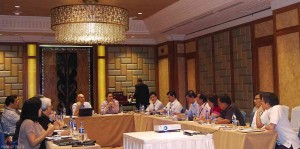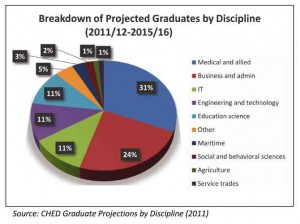The academe, the industry and the promise of a hot link

MATCHMAKING JRU President Vincent Fabella, at left, and BPAP’s Fred Ayala (seated next to him) lead A-I linkup discussion.
Consider this: The industries that are most desirable to the Association of Southeast Asian Nations (Asean), according to the Philippine Business for Education (PBEd), are agro-based goods, fisheries, health care products, rubber-based goods, textiles and clothing, electronic goods, e-ASEAN, automotive products, tourism, wood-based products and logistics.
Our Board of Investments (BOI) lists agribusiness and fisheries, creative industries and knowledge-based services, shipbuilding, mass housing, energy, infrastructure, research and development, green projects, motor vehicles and tourism as priority industries.
By contrast, the projected biggest enrollments in our colleges and universities are in business administration and related courses, followed by information technology-related disciplines, education science and teacher training, engineering and technology, and medical and allied professions. (See pie chart.) These top five fields make up 78 percent of the total enrollment, according to Commission of Higher Education (CHEd) projections for 2012 to 2016.
Languishing in the cellar at only
2 percent projected enrollment are agriculture, forestry, fisheries and veterinary medicine combined. Do the equation and you will see that our students’ career paths are way off the mark when it comes to the sunrise and growth industries.
Article continues after this advertisementClearly, if we are gung ho about Asean 2015 and we want the choicest jobs in the region for our graduates, we will have to do something about our unbelievable obsession with business, education and medical courses. We have to stop ignoring food production and natural resources studies.
Article continues after this advertisementThe fact is that even before we started dreaming about one market with our neighbors, there has been a real need to overhaul our entire educational system. Right now, we have our hopes pinned on the new K to 12 program to redeem basic education. But what about the kids in college?
Our higher education is a big mess that will take an enormous amount of money, attention and political will to clean up. To focus on at least one pile, the PBEd recently put together the 2013 Summit on Higher Education and invited the heads of leading higher education institutions (HEIs) and academic associations, industry associations (who run their own companies), as well as pertinent government agencies and media.
“How do we create a system that can produce people with skills and competencies that are necessary at any point in time,” said PBEd president Chito Salazar. Even before and beyond Asean 2015, in other words.
By the end of the summit, several imperatives had emerged, some of which we think will be interesting to our readers.
First, there is a need for an information system that will make parents, students, media and other stakeholders more aware of school performance and employment trends.
This is a serious concern because high school seniors and their parents usually choose a college or a course, or both, based on aspirational reasons or word-of-mouth information about what is supposed to be a hot career prospect, according to Jose Rizal University president Vincent Fabella. A parent shopping for a school has “a different set of criteria than the industry that four years down the road is looking to make an employment decision.”
Parents, who are paying, usually have a big say on the college and course choices of students and they should be more careful because the decisions they make will have an impact not only on the next four years but the employment future of their children.
But then the often haphazard way of making a career decision is caused precisely by the lack of reliable, up-to-date information about which growth industries graduating high school students should aim for when choosing a college major and which HEIs have a track record of producing the best graduates for the job.
How many parents or high school seniors bother to check if the college or university they are considering is even accredited by CHEd? How many of them take the time to find out how 
“What metrics do we use to communicate to the public how to evaluate a good program versus a not-so-good program?” said Varela.
The summit acknowledged that data should be easily accessible for all stakeholders. One of the recommendations was that websites or portals be established to serve as a one-stop shop for information such as school, industry and company rankings. Also discussed was the need for a communications plan with media that would clearly convey the global value of Filipino graduates. Guidance counselors could also serve as communication partners.
Industry representatives brought up the troubling issue that young people out looking for jobs after four years of college could not analyze information, apply such information to new settings, make appropriate decisions, express their ideas fluently and work in teams—skills that are supposedly at the core of undergraduate learning.
Simply said, our graduates cannot find the dots and connect them.
Fred Ayala, chair of the Business Processing Association of the Philippines (BPAP) pointed out that new hires could always be trained on the specifics of a job but they were expected to come equipped with the “soft skills.”
“We are looking for good communication skills, critical thinking skills, computer literacy, basic work ethics like initiative, punctuality and team spirit,” he said.
To correct this gap, the summit recommended that general education (GE) and “human development” be included in the curriculum of all disciplines and possibly continuing education, too. Another solution might be allowing industry to participate in curriculum development and to lend its experts to HEIs.
The proper promotion and implementation of the general education program at HEIs were seen as the most attainable recommendations at the summit. There is, in fact, a revised GE program that is expected to take wing this year but this is a topic that requires a separate discussion in the near future.
The issue of the moment was, of course, the academe-industry (A-I) linkage. Mapua Institute of Technology president Reynaldo Vea saw it as “a coming together of the academe, industry and government, setting aside parochial concerns… to squarely face the attainment of outcomes and reform the quality assurance system in education.”
In the past, industry linked up with schools only towards the end, when students were about to graduate, noted Fabella, through career fairs and on-the-job training. “It is very clear that they have to immerse themselves totally in the education process… through teacher training, mentorship, research,” he said.
Fr. Jose Ramon Villarin, SJ, Ateneo de Manila University president, said industry had a stake in higher education. “There are other factors… it’s a complicated ecosystem but for now, we are looking at that nexus of academe and industry,” he added. “We will tackle the others at some point but there is a group that is seriously looking into this and is going to move things.”
The summit recommended the setting up of an academe-industry council, which was seen as a mechanism for ensuring constant communication among parents, students, HEIs and industry.
The other suggestions were to design the A-I linkage to Asean scale, bring it to accreditation standards, add it to human resources policies and model its faculty training after the BPAP.
Incentives should also be provided to encourage A-I partnerships, whether in the form of tax breaks or a more holistic approach that allows a company to adopt a school and provide it with resources, such as faculty training.
With Asean 2015 looming in the horizon and with the global competition for knowledge and innovation heating up, the timing is perfect for a university-industry linkage. There is a very real danger that we will end up with an oversupply of college graduates who do not fit the jobs of the future.
But there is also a danger that the A-I linkage will not benefit students as much as it will benefit industry and HEIs. Frequent evaluation of the program and accountability are important. Otherwise, the quality of our graduates will just keep rolling downhill, to a dumpsite of low-paying jobs and bad prospects.
E-mail [email protected].